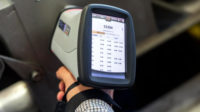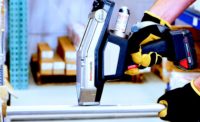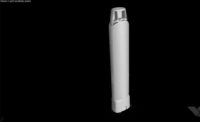Why Identifying Carbon is Crucial for Site and Inspector Safety
Each material has its own set of characteristics, which include tensile strength, malleability and thermal conductivity.

Today there are over 3,500 different grades of steel. In fact, steel is one of the world’s most innovative and essential materials for manufacturing, building and construction. Given its unique properties, steel comes in a variety of compositions with carbon acting as a key element. Foundries add carbon to steel to help increase properties such as corrosion resistance, weldability, ductility, hardness and much more. Carbon is added at small levels from 0.005% to 2% with the slightest adjustment of carbon having an impact on the performance of the steel being produced.
One of the industries that rely heavily on steel is the oil & gas industry, which uses it for assets throughout the worksite from pipeline infrastructure to nuts, bolts and gaskets. Steel plays a considerable role in the safety of the oil & gas industry as well. Its structural integrity and composition are what can lead to corrosion resulting in leaks that risk exposure to harmful chemicals. Exposure to these chemicals can cause environmental issues, loss of valuable resources, or in extreme cases, explosions resulting in destroyed assets and potential loss of life.
Understanding the dangers of material misidentification
The above scenario is why regular material identification and carbon verification are critical safety protocols on any oil & gas worksite. In fact, the American Petroleum Institute (API) has emphasized the importance of these protocols as part of its API Recommended Practice (RP) 578 3rd Edition - “Guidelines for a Material Verification Program (MVP) for New and Existing Assets.”
Traditionally when establishing protocols to enhance worksite safety, reducing the risk of fires, equipment failures and/or transportation-related accidents are top of mind. However, one of the biggest risks is actually caused by exposure to harmful chemicals or environments due to corroded pipes or structural deficits. Metals—such as stainless steel—used in the oil and gas industry, can be highly susceptible to corrosion due to their composite makeup and the build-up of carbon caused by residual elements from the flow of hydrocarbons. Unfortunately, not all metals react to carbon identically, requiring inspection engineers to have a keen understanding of the compositional breakdown of metals on the worksite from stainless steel to copper.
Each material, including composites, has its own set of characteristics, which include tensile strength, malleability and thermal conductivity. These characteristics determine suitable uses for the material. When analyzing material composition, one of the most important aspects inspection personnel need to consider is the material’s susceptibility to corrosion. Materials that corrode easily and/or quickly are less ideal in a piping system than those that can withstand corrosive materials or extreme conditions. Unfortunately, there are a variety of highly technical aspects that can lead to corrosion, such as welding the wrong metals together, the composition of different metals that vary in thermal resistance (example: copper versus stainless steel), and the existence of ferrous materials or sulfurization caused by high-temperature hydrocarbons. If site inspectors don’t have the carbon content right then they won’t know which elements they would be able to weld together.
This complicates the fabrication process when selecting the right materials to match the conditions under which it will be used. For instance, the composition of alloy components used needs to be consistent with the selected or specified construction materials necessary to maximize quality control and minimize the release of hazardous liquids or vapors. To that note, if the wrong piece of material is used, there is a specific rate at which things start to corrode. Once corrosion has started, failure at the site is almost imminent. These types of risk can lead to instant failure at the site, and lead to a site shutdown.
Carbon’s role in effective welding
Guaranteeing the safety of site materials doesn’t stop at material identification. When working with different materials, there needs to be an understanding of how those materials will either react to or work well with one another. When welding, carbon equivalent (or CE) calculations are required to predict heat-affected zones, also referred to as HAZ. This can determine if the two joining materials are compatible, and if further site precautions need to be taken, like prescriptive heat treatment, the use of low hydrogen electrodes, or controlling the heat input.
When higher levels of carbon are identified, the material used will typically have increased hardness, brittleness, yield point, tensile strength, and in some field environments can lead to increased rusting. These properties result in decreased weldability, plasticity, ductility, and air corrosion resistance, all of which are important for site inspectors to know as they start working with the materials.

How can you understand and identify levels of carbon?
Analyzing carbon levels is a highly-technical task that can’t be achieved with the human eye. Over the years, the industry has adopted technologies such as optical emission spectroscopy (OES) and more recently laser-induced breakdown spectroscopy (LIBS) to help inspection personnel better understand the carbon makeup of the assets throughout a worksite.
When measuring carbon, inspection personnel are usually supplied with either OES or LIBS instruments. Both technologies are effective but vary drastically in functionality. For example, these technologies operate differently: OES applies electrical energy in the form of a spark generated between an electrode and a sample, while LIBS uses a high-energy pulsed laser to ablate a sample.
Setup for the inspection materials can limit productivity. Both OES and LIBS technologies require inspectors to follow a series of steps to test performance and accuracy. However, LIBS technologies take less than 10 minutes to set up while OES can take upwards of 20 to 30 minutes and consists of several complex steps. Analysis time with LIBS technology takes approximately 10 seconds compared to approximately 15 seconds on mobile OES.
There are also challenges that are present at the site, particularly related to worker fatigue when lugging equipment around an inspection area. One of the ways to address this challenge is for site inspectors to use handheld tools. This way, inspectors can avoid the use of bulky devices which are cumbersome to carry. Handheld LIBS easily and safely travels with a user for various tasks where mobile OES can be difficult to deploy. When factoring in the argon tank required to accompany mobile OES, users can expect to add up to an additional 40-80 pounds which causes significant limitations to accessibility and mobility. Without being able to identify materials with the naked eye, and not wanting to carry around bulky inspection materials, using a portable handheld-device allows for inspectors to quickly and accurately identify materials being used. Having the ability to quickly detect and identify low alloy/carbon steels and L and H grade steels helps employees understand the materials and competition of their worksite in record time. Accuracy and repeatability are essential to validate the importance and value of the technology and ensure the safety of the worksite.
The benefits of understanding the worksite
An active oil and gas site can pose a series of risks to those working on it. Having a better understanding of the materials being used and their carbon makeup is key to securing a safe worksite, allowing inspection personnel to mitigate potential risks caused by corrosion and welding mistakes and ultimately leading to less downtime, greater productivity and reduced costs. NDT
Looking for a reprint of this article?
From high-res PDFs to custom plaques, order your copy today!





